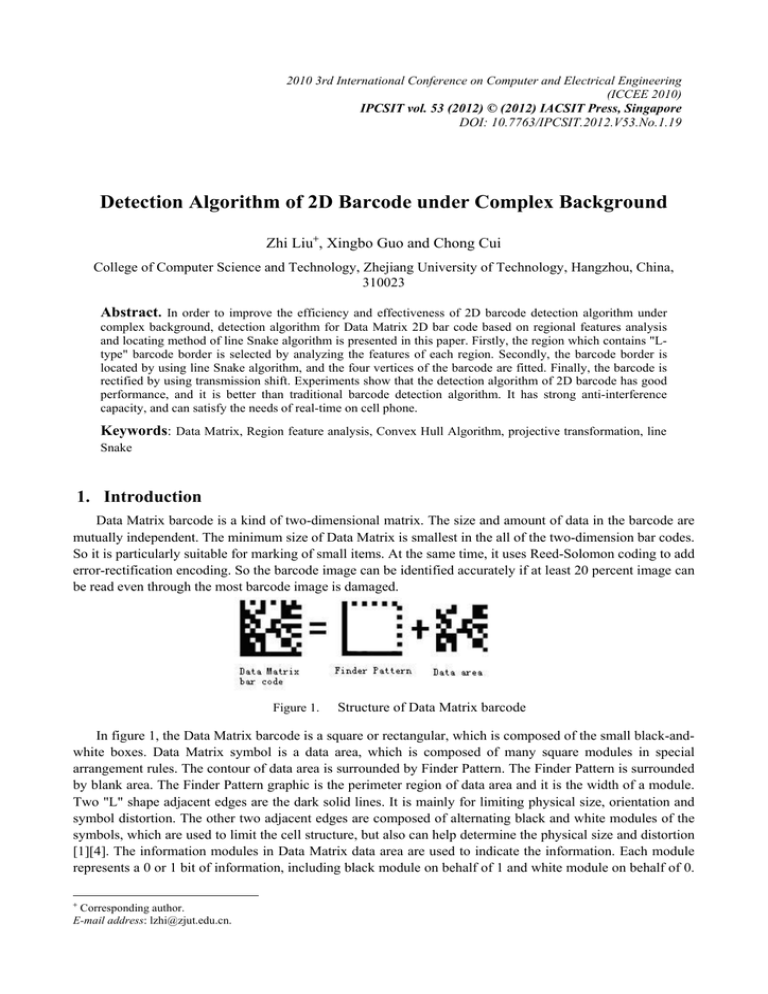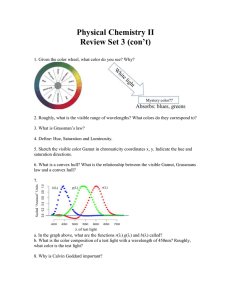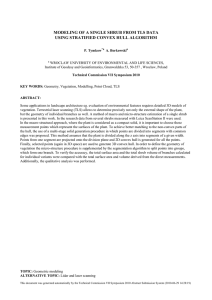Document 13136139
advertisement

2010 3rd International Conference on Computer and Electrical Engineering
(ICCEE 2010)
IPCSIT vol. 53 (2012) © (2012) IACSIT Press, Singapore
DOI: 10.7763/IPCSIT.2012.V53.No.1.19
Detection Algorithm of 2D Barcode under Complex Background
Zhi Liu+, Xingbo Guo and Chong Cui
College of Computer Science and Technology, Zhejiang University of Technology, Hangzhou, China,
310023
Abstract. In order to improve the efficiency and effectiveness of 2D barcode detection algorithm under
complex background, detection algorithm for Data Matrix 2D bar code based on regional features analysis
and locating method of line Snake algorithm is presented in this paper. Firstly, the region which contains "Ltype" barcode border is selected by analyzing the features of each region. Secondly, the barcode border is
located by using line Snake algorithm, and the four vertices of the barcode are fitted. Finally, the barcode is
rectified by using transmission shift. Experiments show that the detection algorithm of 2D barcode has good
performance, and it is better than traditional barcode detection algorithm. It has strong anti-interference
capacity, and can satisfy the needs of real-time on cell phone.
Keywords: Data Matrix, Region feature analysis, Convex Hull Algorithm, projective transformation, line
Snake
1. Introduction
Data Matrix barcode is a kind of two-dimensional matrix. The size and amount of data in the barcode are
mutually independent. The minimum size of Data Matrix is smallest in the all of the two-dimension bar codes.
So it is particularly suitable for marking of small items. At the same time, it uses Reed-Solomon coding to add
error-rectification encoding. So the barcode image can be identified accurately if at least 20 percent image can
be read even through the most barcode image is damaged.
Figure 1.
Structure of Data Matrix barcode
In figure 1, the Data Matrix barcode is a square or rectangular, which is composed of the small black-andwhite boxes. Data Matrix symbol is a data area, which is composed of many square modules in special
arrangement rules. The contour of data area is surrounded by Finder Pattern. The Finder Pattern is surrounded
by blank area. The Finder Pattern graphic is the perimeter region of data area and it is the width of a module.
Two "L" shape adjacent edges are the dark solid lines. It is mainly for limiting physical size, orientation and
symbol distortion. The other two adjacent edges are composed of alternating black and white modules of the
symbols, which are used to limit the cell structure, but also can help determine the physical size and distortion
[1][4]. The information modules in Data Matrix data area are used to indicate the information. Each module
represents a 0 or 1 bit of information, including black module on behalf of 1 and white module on behalf of 0.
+
Corresponding author.
E-mail address: lzhi@zjut.edu.cn.
Data Matrix can code various character sets, including all of the ASCII characters and expansion of ASCII
characters, letters, Chinese characters, images and other information. Data Matrix bar code can accommodate
the largest 3116 digital information, 2335 text information, and 1556-bit information.
Currently, the bar code detection algorithms are mainly two categories: 1) the bar code detection
algorithm based on line detection; 2) the bar code detection algorithm based on regional features. The main
representative of the first method is the Hough transformation and its improved algorithm. The algorithm uses
edge detection algorithm for image edge points. Then each edge point in Cartesian coordinates is mapped to a
Sine curve in polar coordinates. Finally through detecting the peak value of intersection point in the Sine
curve, the straight edge of bar code is located. Such algorithm has the advantage of strong anti-interference
and is not sensitive to the noise of the image. But it is an exhaustive search way. Its computational complexity
and space complexity are much high, and line length and endpoint information are lost in the process of
transformation. Although researchers have proposed improved algorithms, there is no doubt the complexity of
the algorithm is increased[2]. The main representative of the second class of algorithm is the convex hull
algorithm [3]. The algorithm will segment the image into different connected components with the regional
marks. Then the regional features are analyzed. The suitable sub-regions are filtered and these sub-regions can
be merged. Finally, the convex hull algorithm is used to extract regional convex hull polygon. Then the
simplified convex hull points are used to fit bar code boundary. The advantage of this algorithm is of low
computational complexity and high real time. In addition, all points used in the convex hull algorithm are the
edge points. So computational complexity is less However, the disadvantage of this method is that the points
used in convex hull algorithm come from ideal and complete bar code edge points. Therefore, when the
barcode image with complex background, the bar code region filtered will be incomplete or the bar code area
will contain background area. The convex hull algorithm will not accurately detect the bar code region.
In order to further improve detection speed and enhance detection effect under complex background for
2D bar code, a new 2D bar code detection algorithm combining the line detection algorithm and convex hull
algorithm is proposed in this paper. Firstly, the 2D bar code image is enhanced and marked the bar code
region. The color, geometric feature, gradient feature and regional "L-type" edge feature in each connected
region is analyzed and the interfering background information are removed. The main region in the bar code
image is filtered. Finally, the line Snake algorithm is used to fit the four boundaries of bar code and four
vertices are positioned precisely. The bar code is rectified through projective transformation. Experimental
results show that the algorithm can effectively eliminate the interference from complex background, quickly
and accurately detect the bar code region. The detection speed and detection results have been significantly
improved.
2. Regional Features Analysisi and Selection
Due to uneven illumination, noise and the impact of low-resolution camera, the image captured by mobile
camera often appears obvious optical degradation. Therefore, in order to improve image quality, outstanding
bar code features, the bar code image is preprocessed and the enhanced binary image is obtained. Based on
this binary image, connected regions are marked. Because of the impact of background interference and noise,
the marked connected regions will generally reach dozens. In this paper, according to the four features of
color, geometric structure, gradient and regional "L-type" edge in each connected region, the bar code region
is selected. If the proportion of color points in some region is greater T2, then the region is considered as the
background region and it will be set to white color. Here, T1 is set to 2300 and T2 is set to 0.005 according to
the statistics of color information in the bar code image.
2.1 Color feature
As the Data Matrix 2D bar code is composed of black and white block alternately without color
information. Therefore, if a connected region is part of the barcode, then the region should not contain color
information. Even if it is impacted by the optical degradation and the phenomenon of mild color cast appears,
the color points will not be particularly significant or only take a very small ratio. Using this feature, the
background with obvious color information can be distinguished from the image. Then the pixel in each area
will be calculated the variance of three color channels R, G, B. if the value is greater than T1, the pixel is
considered as a color point.
2.2 Geometric feature
Under the complex background, it can not be completely removed the background interference depending
on color filtering alone. Data Matrix 2D bar code is a square structure and its length is equal to its width. It is
composed of black and white blocks. Using these features, the bar code region can be distinguished from
irregular background area.
Therefore, the selection criterion of geometric feature in bar code region is defined below:
(1) Because of the square structure of 2D bar code, the formation of the image will be a kind diamond
even there is deformation during the shooting. The lengths of four edges will not change so much. Here, we
assume that the height of i-th connected region Ri is H( Ri ) , and width is W( Ri ) .The filter conditions are set
below:
(1)
H : W <= 2 : 1 (assuming H > W )
(2) The default bar code image will occupy the main position in the whole image captured by mobile
camera and the bar code is composed of alternating black and white blocks. Therefore, if a connected region
that contains the black pixels much more or less than white pixels, it can be regarded as non-barcode region.
Therefore, we assume that the black and white pixel ratio in the i-th connected region Ri is P(Ri ) .The filter
condition is defined as below:
(2)
P( Ri ) < 90% && P( Ri ) > 10%
Only two conditions are satisfied and the region can be considered as possible bar code area and it can be
a candidate for feature filtering on the next step. Otherwise it will be marked as the background.
2.3 Gradient feature
Data Matrix 2D bar code is formed by the black and white blocks. In the perpendicular direction, it has
strong edge feature and is significantly different from the other edge of the text or pattern features. Therefore,
if the region is the part of the bar code, then in a perpendicular direction, the region must have very strong
edge features. Using this feature, the background with gray uniform distribution and most of background, such
as text or pattern can be distinguished.
In this paper, Krisch differential operator is used to detect the edge on the direction of 0o,45o,90o,
and 135o. The edge image on the direction of 0o,45o,90o, and 135o can be obtained. Then the grayscale
value on these directions are calculated and the number of grayscale value which is greater than a threshold
can be recorded as N 0 , N 45 , N 90 , N135 . Because in the standard bar code image. The number of pixels on the
edge image at the perpendicular direction are roughly equal. The number of pixels on the edge image at the
non-perpendicular direction is much different. Therefore, the value which is equal to the pixel difference
between edge image at perpendicular direction minus the pixel difference between the edge image at nonperpendicular direction can be used to represent the strength of edge image[4].
Define the edge strength Ri of the region as below:
Edge(Ri ) = (N0 − N45)2 + (N0 − N135)2 + (N90 − N45)2 + (N90 − N135)2 − (N0 − N90)2 − (N45 − N135)2
(3)
According to the edge strength defined in formula(3), the regions can be sorted. The regions with two
largest edge strengths will be selected as candidates and other regions are marked as background regions.
2.4 "L-type" edge feature
Because the “L-type” edge feature is a very important feature for the Data Matrix bar code. Using this
feature, the pseudo bar code region that can not be filtered in the first three steps will be removed.
Firstly, binary bar code image will be detected on edge image. Here, Roberts operator is used. In Roberts
operator, the pixel difference between adjacent pixels on the diagonal direction is used to approximate
gradient magnitude and implement edge detection. This way has high positioning accuracy and strong
robustness for the defacement or deformation "L-type" border.
Secondly, the Grammar convex hull algorithm is used to detect the points on the region edge in order to
obtain the regional convex polygon. The length and angle of adjacent side in convex hull are used to simplify
hull vertex.
Finally, pixel density D( Ei ) on each convex hull edge Ei is calculated. If D( Ei ) > 0.5 , the convex side Ei is
judged as a real edge. Through detecting convex polygonal region whether or not exists "L-type" solid side
will determine the final bar code region.
3. Bar Code Positioning
As the Data Matrix is not connected, bar code region obtained through the feature analysis is not complete.
The common solution is to merge and compensate the bar code region. However, under complex background,
this approach is vulnerable to the interference of the background around the bar. It will cause the region over
merged. In the meantime, it will be impacted by the defacement and noise, and this make it easy to lose the
small part in the bar area. General Data Matrix bar code is a rectangular or square structure. Even the
deformation of bar code is caused by the shooting angle, the deformed bar code will look like a class of
parallelogram structure. Based on this geometric feature, the "L-type" edge will be used to fit parallelogram
structure in order to approximate bar code area. Then the line Snake algorithm is used to position the other
two virtual edges in the bar code. The four vertices of bar code will be gotten.
3.1 Line Snake model
Traditional Snake algorithm usually takes the single pixel as the basic element. In optimization process,
according to these pixels information underlying, Snake algorithm makes the curve converge to the correct
contour location obeying to the principle of energy minimization. But it makes the initial conditions on Snake
much harsh. There are some issues, such as stability, computational efficiency and so on[5].
In view of the shortage above, Tang Liang et al [5] proposed a model based on line Snake, a large number
chaos information are organized and are provided for Snake to choose. The general formula is as follows:
n
(4)
E =
(E
(l ) + E
( l ))
∑
int
i
ext
i
i=1
E int (li ) = a l i − l i −1
2
+ b | θ i − θ i −1 | 2
(5)
2
i
(6)
E ext (li ) = −∇l
In which, the n is an contour of the object which is to be extracted and it is composed of n straight lines; E,
Eint (li ) and Eext (li ) are total energy function, internal energy function, and external energy function in line Snake
separately. The li is the i-th straight line.
li − li −1
represents the connected distance between two straight lines.
∇l represents the average gradient of the line [5].
The method uses a linear initial relationship and applies the underlying image information. So it reduces
the burden on stability and computational efficiency for Snake algorithm. However, this method still has an
obvious deficiency. In this way, only a few lines with great change on gradient can cause changes in Snake
function. In order to overcome this shortcoming, a way of traversing lines in the small area is used to detect
Snake edge in this paper.
3.2 Positioning bar code based on line Snake
In the process of positioning Data Matrix bar code, the virtual edge is composed of lines with equal
spacing on the same line and the distance variance is minimal. According to these features, we can assume a =
1, b = 0, and li − li −1 = min{l ( Ai , Bi ),l ( Ai , Bi−1 ),l ( Ai −1 , Bi ),l ( Ai−1 , Bi−1 )} . In which, Ai and Bi are the endpoints the line
Li. ∇l is the sum of gradients from the pixels that are vertical to straight line.
Concrete steps are as follows:
1) Based on Data Matrix 2D bar code feature of rectangular structure, using of "L-type" edge to fit
parallelogram and approximate bar code region. The two sides L0 and L1 fitted will be set as the initial
position of line Snake model.
2) The line L0 will work as the initial position in Snake algorithm as and linear energy will be calculated.
3) The intersection of line L0 and "L-type" boundary is set as the dot. The line is rotated in the angle of 30
degree with line L0 and calculating linear energy in accordance with equation (5) and (6).
4) The line with minimum energy is selected as the virtual edge in bar code. Then repeating steps 2)-3)
and detecting another virtual edge around L1.
3.3 Rectifying bar code
In the practical application of bar code detection, the bar code image often occurs geometric distortion,
such as skew distortion, perspective distortion, scale distortion. If the image is not rectified accurately, it will
make a big difficult to the bar code identification. Therefore, the image rectification in the process of
identifying bar code plays an important role. Commonly used methods in image rectification methods are
perspective transformation method and control point transformation method. Perspective transformation
method is mainly based on the camera imaging principle; control point transformation method is based on the
correspondence relationship between control points and the bilinear interpolation method is used to rectify
image[6].
In this paper, projective transformation is used to rectify the Data Matrix 2D bar code. The projective
transformation is defined as follows:
ax + by + c
(7)
u=
gx + hy + 1
v=
dx + ey + f
gx + hy + 1
(8)
In which, the (x, y) is pixel coordinate in coordinate system of reference image. The (u, v) is the
corresponding pixel coordinate in the coordinate system. The a, b, c, d, e, g and h is the transformation
coefficients. Given the four vertices in bar code and its corresponding point in the transformation space, the
eight linear equations can be obtained. As long as any of all three points are not in a same straight line, the 8
transformation parameters can be solved. So transformation relationship can be obtained before and after the
projective transformation. That means the space coordinate position used for projective transformation of bar
code can be achieved. So the bar code can be restored.
4. Experimental Analysis
In this paper, the Nokia N73 mobile phone is used to capture 100 bar code images under the complex
background and these images are detected and positioned. The existing Hough algorithm and the convex hull
algorithm are compared with this method proposed here on the positioning accuracy and processing speed.
The result is shown in Tab.1 below:
TABLE I.
Positing
accuracy (%)
Processing
speed(s)
COMPARISON AMONG THREE ALGORITHMS
Hough
algorithm
Convex hull
algorithm
Method
proposed here
96
80
97
28.23
4.42
3.35
It can be found from the Tab.1 that the accuracy of this detection method is higher than the Hough
algorithm and convex hull algorithm. It is mainly due to that Hough algorithm is not sensitive to interference
and intermittent in the curve. So it is vulnerable to make a bias in positioning the virtual border of bar code.
The splitting and merging algorithm in the convex hull detection algorithm can be impacted by the complex
background and their own regional distance. So the over segmentation and insufficient segmentation will
appear. This algorithm only selects the main bar code region containing with "L-type" boundary and then
detects virtual boundary through line Snake. It can effectively avoid the noise and interference of background.
So it has good robustness. For the computation time, Hough algorithm is an exhaustive search and its
computational complexity and space complexity are high. The line length and endpoint information can be
lost in the process of transformation. The region merging algorithm in the Convex hull algorithm needs
several iterations. The more the bar code regions are, the longer run time is. This algorithm avoids the regional
merging process. It uses the parallelogram side fitted as the initial location for line Snake algorithm and
simplifies the calculation.
Fig.4 shows that a bar code image under complex background is detected by this algorithm proposed in
this paper. The Fig.4 (a) is the original image; The Fig.2 is the enhanced binary image; The Fig.3 is the image
fitted through color feature; The Fig.4 is the image fitted through geometric feature; The Fig.5 is the image
fitted through gradient feature; The Fig.6 is the image fitted through “L-type” edge; The Fig.7 is the image
positioned through line Snake; The Fig.8 is the image rectified through projective transformation.
Experiments show that this bar code detection algorithm based on regional feature analysis and positioning by
line Snake algorithm can more effectively detect the bar code.
Figure 2.
Figure 3.
Figure 4.
Figure 5.
Figure 6.
The original image
The enhanced binary image
The image fitted through color feature
The image fitted through geometric feature
The image fitted through gradient feature
Figure 7.
The image fitted through “L-type” edge
Figure 8.
The image positioned through line Snake
Figure 9.
The image rectified through projective transformation
5. Conclusions
Aiming at the black and white 2D bar code under complex background, a kind of bar code detection
algorithm combining the regional feature analysis with positioning through the line Snake algorithm is
proposed in this paper. In this method, the main region of bar code with "L-type" edge will be selected
through regional feature analysis. Then the bar code region is fitted according to the "L-type" edge. The four
edges of bar code can be positioned accurately by line Snake algorithm. Finally, the bar code is rectified
through projective transformation using the four vertices. Experiments show that the algorithm can segment
the 2D bar code from complex background well. In the actual bar code images captured by mobile camera, it
has good detection effective. It runs fast and consumes less space. It can well meet the real-time requirement
on the mobile terminal.
6. References
[1] Information technology–International symbology specification–Data Matrix [M]. INTERNATIONAL
STANDARD ISO/IEC 16022: 2000.
[2] R. Muniz, L. Junco, and A. Otero, A robust software barcode reader using the Hough transform, Proceedings of
IEEE international Conference on Information, Intelligence, and Systems, 1999, 313–319.
[3] Jian Lu, “Research on the Recognition of Two Dimensioal Bar Code on Mobile Terminal”, Master’s Thesis,
Zhejiang University of Technology,2009.
[4] Zhongning Liu, “Detection and Localization of Bar Code in Complicated Background”, JOURNAL OF NANJING
UNIVERSITY OF AERONAUTICS & ASTRONAUTICS, 2005,37(1),pp: 65-69.
[5] Liang Tang, Weixin Xie, “Line Snake and its application in building extraction ”, JOURNAL OF XIDIAN
UNIVERSITY(NATURAL SCIENCE) , 2005,32(1), pp:60-65.
[6] Donghong Hu, “Comparisons of two kinds of image rectification algorithms”, COMPUTER ENGINEERING
AND APPLICATIONS, 2009,45(13),pp:191-194.



